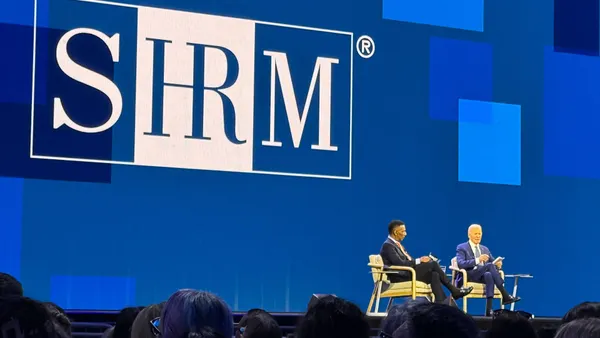When an organization endures relentless change—restructures, layoffs, or major transformations—it can emerge operationally intact but emotionally worn down. The goals are still clear on paper, but the people pursuing them are running on empty. Trust fades, communication frays, and connection gives way to quiet fatigue.
People leaders often feel the weight of organizational change the most. They’re asked to rally teams toward the future while repairing the strain left behind. The truth is that you can’t build momentum on exhaustion. Like an Army battalion returning from deployment, the mission can’t advance until the team has time—and permission—to recover.
The path from burnout to belonging doesn’t start with new initiatives. It begins with communication grounded in honesty, empathy, and courage.
Leadership under strain
Strong leadership isn’t about perfection—it’s about presence. In times of disruption, people watch leaders more closely than ever. They’re not looking for flawless answers; they’re looking for signs of steadiness, truth, and care.
In the military, a commander quickly learns that authority alone doesn’t earn trust. Soldiers follow clarity and consistency. They need to know that when things go wrong—and they always do—their leader will tell them the truth, shoulder the responsibility, and take care of the team.
In business, it’s no different. When employees face constant change, they need to believe that leaders are aligned, clearly communicating, and acting with integrity. Without that, even the most strategic plans lose their force.
Step 1: Lead with transparent communication
Transparency isn’t just a management technique—it’s an act of respect. When leaders tell the truth early, own mistakes, and explain decisions, they send a message: you matter enough to be trusted with the truth.
Whether commanding an Army unit or leading a department, the most effective leaders replace performance theater with honest conversation. They identify what’s broken, share what’s changing, and commit to measurable progress. This kind of communication transforms accountability from a fear-based exercise into a shared commitment.
When people feel informed and included, they move from compliance to ownership. They stop hiding issues and start solving them. Transparency becomes the first step in rebuilding trust, which in turn fuels resilience and performance.
Step 2: Pause with purpose
In any high-stakes environment, momentum can become a false idol. The instinct to “keep pushing” feels productive, but in reality, it can accelerate burnout.
The most seasoned commanders and executives alike understand that progress sometimes requires a pause. In the military, a stand-down isn’t a failure, it’s a deliberate reset. It’s time to rest, repair, and reorient before the next mission.
Civilian organizations can do the same. Hit pause on nonessential projects. Simplify communication. Reassess priorities. Ask: what really moves the mission forward, and what’s just noise?
These purposeful pauses give teams a chance to recover and reconnect. When you slow down to realign, you actually speed up what matters most: trust, readiness, and focus.
Step 3: Create new rituals of connection
Culture is shaped by what teams repeatedly do, not what leaders occasionally say. After long periods of strain, teams need small, reliable practices that rebuild connection and communication.
Start meetings with a “risks and realities” round—what’s getting in our way, and what's going right? Invite dissent before finalizing decisions. Close feedback loops within 10 days so people know their voices make a difference.
These rituals may seem simple, but they carry immense power. They transform honesty from a risk into a norm. Over time, these consistent gestures of listening and follow-through create belonging. People learn that their input matters, their well-being is protected, and their leaders mean what they say.
In both the military and business, these rituals reinforce a fundamental truth: the teams with the most trust are the strongest.
Step 4: Empower the manager layer
In any organization, culture travels fastest through its middle layer. Managers are the bridge between strategy and execution—the ones translating lofty goals into daily behaviors.
Invest in them as you would any mission-critical system. Equip them to model candor, care, and steadiness under pressure. Coach them to not only manage tasks but also lead people.
Define a few observable leadership behaviors—expertise, empathy, and integrity—and celebrate them visibly. Create feedback rhythms that help managers catch issues early. When they are trusted to act and are supported to lead, managers become cultural multipliers.
In the military, this is called command intent: empowering each leader at every level to make the right call when it matters. In business, it’s the same principle—give your leaders clarity and confidence then trust them to act.
From fatigue to strength
When organizations commit to these four steps—transparency, purposeful pauses, restorative rituals, and empowered managers—they do more than recover, they evolve.
Here’s what changes:
- Communication deepens. Teams speak up earlier, reducing surprises and misunderstandings.
- Trust strengthens. People see alignment between words and actions.
- Performance rebounds. Work aligns with reality, not wishful thinking.
- Belonging grows. Employees take pride not only in what they achieve but also in how they do it together.
These aren’t quick fixes. They’re long-term leadership practices that turn transition fatigue into adaptive strength.
Leading beyond burnout
Effective leadership, whether in combat or corporate life, is fundamentally human. It’s about creating trust in uncertainty, clarity in confusion, and unity in diversity.
The best leaders understand that performance follows care. They make it safe for people to tell the truth, to ask for help, and to learn out loud. They replace empty perseverance with honest repair. And they treat belonging not as a luxury but as the foundation of sustained performance.
Change will always come—but when leaders communicate clearly, act consistently, and care deeply, their teams will follow them anywhere.










